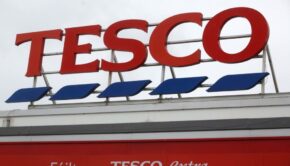A new joint number one

While SuperValu was in full celebration mode last month after emerging as Ireland’s new number one take-home grocery retailer, Tesco has once again drawn level with the Musgrave Group’s prime contender. What conclusions from all this flux can we draw about the state of Ireland’s grocery sector, asks Gillian Hamill
15 May 2015
Always eagerly anticipated within the trade, the latest set of grocery market share figures from Kantar Worldpanel has provided even more interesting reading than most. Not to mention a cautionary tale; when it comes to the cut-throat world of Irish grocery retail, always expect the unexpected. Although SuperValu was last month crowned Ireland’s largest grocery retailer and was deservedly celebrating this achievement, Tesco and SuperValu have now once again drawn level, both holding 25% market share a piece. Given the fiercely competitive state of the Irish market, this is not altogether surprising. No doubt it’s extremely welcome news for Tesco though, given the difficulties the multiple has faced of late.
Troubles at Tesco
Tesco’s turbulence has been well-documented, with the group recording an annual loss of £6.4 billion last month – the worst result in its 96 year history. Nevertheless with new CEO ‘Drastic Dave’ Lewis at the helm, the retail giant in its entirety is a long way from down and out. The majority of Tesco’s losses can be attributed to a £4.7 billion write-down in the value of its property portfolio. In other words, the plaster has now been well and truly ripped off a festering old wound. Although a write-down of this magnitude must seriously hurt at the time, the silver lining is that the casualty has now been given room to breathe. “The simple fact is the value of out-of-town sites has fallen as openings have been mothballed,” says David Gray, retail analyst at Planet Retail. “Although it’s been a disastrous year, Tesco is in effect cleaning out the closet – enabling management to start with a clean slate in 2015/16 upon which to rebuild the business.”
Tesco’s Irish business has suffered similarly grievous injuries. In fact, Tesco’s Irish arm recorded the worst performance out of any of the retailer’s businesses last year. Annual sales at Tesco Ireland fell to €2.56 billion, an amount not seen for many years. Even in 2009, at the height of the recession, sales stood at €3.15 billion. Journalist Dan White has also revealed that an overstatement of profits worth £63m (€88m) occurred at Tesco’s Irish business, largely attributable to supplier payments being incorrectly recorded as profits.
Down but not out
How then, has Tesco pulled off what appears to be a Lazurus-like revival and brought itself up neck and neck with the so-recently triumphant SuperValu? The explanation provided by Kantar is that while “Tesco’s market share is lower year-on-year, it has improved its position versus last month. This recent improvement has lifted its market share back up to 25%, in line with SuperValu as Ireland’s joint largest supermarket. The amount of groceries sold at Tesco has remained flat, but value sales have declined because of shoppers choosing to pick up cheaper goods in-store. SuperValu’s sales have remained in growth for the eighth month in a row, largely thanks to the retailer’s ability to consistently win new shoppers. SuperValu’s plan to open four new stores this year gives it the opportunity to grow sales further and out-perform the overall market.”
Tesco’s return to grace is also less of a shock when the positive indicators from the group’s performance last month are examined. At the time, Kantar Worldpanel director David Berry said: “Tesco’s story is one of mixed performance. Sales are down year-on-year and as a result market share has dipped from 25.9% to 24.7%. While Tesco will be disappointed to have lost its number one position, there are some positive signs for the retailer. It has not lost shoppers since this time last year and its customers are making the same number of shopping trips with increased average basket sizes – the most positive results for these metrics in more than two years. This points to an interesting battle over the coming months.”
Flying the flag for Ireland
What’s more, instead of languishing in the terrors, Tesco Ireland resolutely fought back at its recent Tesco Taste Bud event in Dublin city centre. As part of the announcement that 20 Irish food and drinks companies were joining its fourth annual supplier development programme, Tesco commissioned independent research from Indecon. This found that the wider Tesco group is the largest buyer of Irish food and drink in the world, with purchases of €1.57 billion. This puts it significantly ahead of other major supporters of Irish food such as McDonalds, which sources all its beef here. Of this €1.57 billion, nearly €600 million of these purchases are accounted for by Tesco Ireland, while the remaining €980 million is sold to Tesco stores abroad. Alan Gray of Indecon calculated that Tesco therefore accounts for more than 11% of all Irish food and drink exports. Given that a large part of SuperValu’s marketing centres around its Irish credentials, it’s obvious that Tesco isn’t afraid to fly the green flag loud and proud on its own turf. The ebullient retailer is sending a clear message that it’s accustomed to being ‘number one’ and isn’t prepared to simply lie down and be eclipsed without a fight.
A further kingpin in SuperValu’s marketing strategy is not just that it’s Irish but local, with local independent retailers running stores and helping to deliver ‘good food karma’ by supporting their own communities. As Martin Kelleher, SuperValu managing director pointed out: “Local ownership is one of our unique selling points: the fact that our stores are operated by people from the local community, the store owner knows his or her customers and what they want. For example, as store owners can source directly from local suppliers, you will find products on our shelves that you simply cannot buy in any of the other grocery retailers.”
David Berry, director at Kantar Worldpanel agreed that this model has proven advantageous for SuperValu so far. “From a positive point of view, they’re very adaptable,” he told ShelfLife. “It’s within the owner’s control what they do day-to-day. They can be very responsive to customers’ needs and be very responsive to threats so I think that has worked quite well to their advantage.”

Kantar Worldpanel director David Berry says the amount of groceries sold at Tesco has remained flat, but value sales have declined because of shoppers choosing to pick up cheaper goods in-store
Still more to give
Independent retail expert Joe Comerford has also been impressed. “I think SuperValu have it right. It’s well controlled from Musgraves HQ, it’s well supervised, their advertising is very strong, their promotional activity is very strong and their range is very strong,” he said. However while the independent dodo (dealer owned, dealer operated) model is working well for SuperValu and the Musgrave Group, Comerford feels the former Superquinn coco (company owned, company operated) stores “still have more to give”. Speaking about the dodo model, he says: “I think the independent retailer controls the issues as far as the customer is concerned. Musgraves has a very good supervisory programme to maintain the standards. They’ve got a very good planogram system whereby their gap management and all that sort of detailed management is supplied to the retailers and they look after it, they check it as well to make sure that it’s all being done properly. They are on top of their game.”
However he adds: “The old Superquinn that has been rebranded, even though they have put up a lot of footfall, I think they still have more to give, they’re still not as customer-focused as the independent dodos…I think they will increase if they become more customer-focused which they should because that’s the old successful Superquinn brand if you like. But over the years, it has fallen back and that’s well known in the trade…I think they went through a period whereby staff and management became lax. They’re finding it difficult to bring that back into the customer-focused philosophy that Feargal had and that is now in the independent SuperValu.”
While he believes some improvement could still occur at the former Superquinn stores, Comerford is warm in his praise for independent SuperValu retailers such as Eddie Kane who recently won the SuperValu Store of the Year Award. “I would go as far as to say they’ve created a unique destination shop with their range and their high standards,” he said.
Dunnes not struck by strike
Another reason that the Kantar results were so widely anticipated this month was that it would give an indication of how the recent industrial action at Dunnes Stores had affected sales. The news was resoundingly positive for management, as far as the numbers are concerned. Among the big three retailers Dunnes has posted the strongest sales growth of 3.6%, lifting its market share from 21.5% to 22.0%. According to Berry: “This increase comes despite the recent industrial action taken by staff in the build up to Easter. One of the key positives for Dunnes has been its strength in Dublin, an area where grocery sales are growing and where Dunnes accounts for over a quarter of shopper spend.” Interestingly, had the strike action held more sway over Dunnes’ figures, Berry told ShelfLife last month that this likely would have played out to Tesco’s advantage. “There’s a very, very close correlation between Dunnes and Tesco’s performance in that they’re similar geographically and compete for a similar shopping trip, in that it’s the bigger trip that they compete for. If Dunnes has been adversely affected then that could be of benefit to Tesco,” Berry said.
Joe Comerford correctly predicted that the strike action was unlikely to negatively influence Dunnes’ results. “As far as Dunnes are concerned, I don’t think it’s going to make any difference,” he said. “I was in Dunnes Stores, Cornelscourt after the strike and I was talking to the staff on the checkout and whereas they didn’t agree with the contract that some of the staff got or have, the ones I spoke to, they said it didn’t bother them one way or the other; they got as many hours as they wanted and didn’t want any more. [Nevertheless] they didn’t pass the picket, they felt that they had to support those that wanted to be out.”
He added at the time of our interview last month: “Is it going to make any difference to their market share? I very much doubt it. They’re buying business again with their vouchers; they’re very, very busy. The day after the strike I was in there on Good Friday, a girl on the checkout told me they were packed from 7 o’clock that morning. Busier than Christmas was the way they described it. So whatever they lost on the Thursday, I certainly think they picked an awful lot of it up on the Friday and Saturday.”
Surprises continue
While Dunnes has recorded a surprisingly good result, the surprises don’t end there. According to Berry: “One of the most interesting trends in the latest data is the slowing growth rate of both Aldi and Lidl. While the 8.8% growth posted by Aldi and 7.8% for Lidl remains impressive, this is the first time since 2010 that both Aldi and Lidl have grown their sales by less than 10%.” Now that Aldi and Lidl have effectively won round the Irish middle ‘coping’ classes to their line of thinking, are there many customers out there who have yet to be converted at this stage? Might it be that after finding a little more cash in their pockets, floating shoppers are beginning to drift back to the comfort offered by traditional Irish supermarkets such as Dunnes?
Regardless of the fluctuations in fortunes that will no doubt continue to characterise the Irish grocery sector, no-one can accuse the Musgrave Group of being naïve about its new-found number one status. When the news was announced last month, Martin Kelleher wisely reflected: “Clearly the Irish grocery market is highly competitive and will continue to be neck and neck in the future. We aim to repay our customers’ loyalty by continuing to invest in our brand and further improving our offer.” Although SuperValu won the battle last month, the war continues to rage on and the ultimate winner looks set to be the Irish consumer.



 Print
Print




Fans 0
Followers